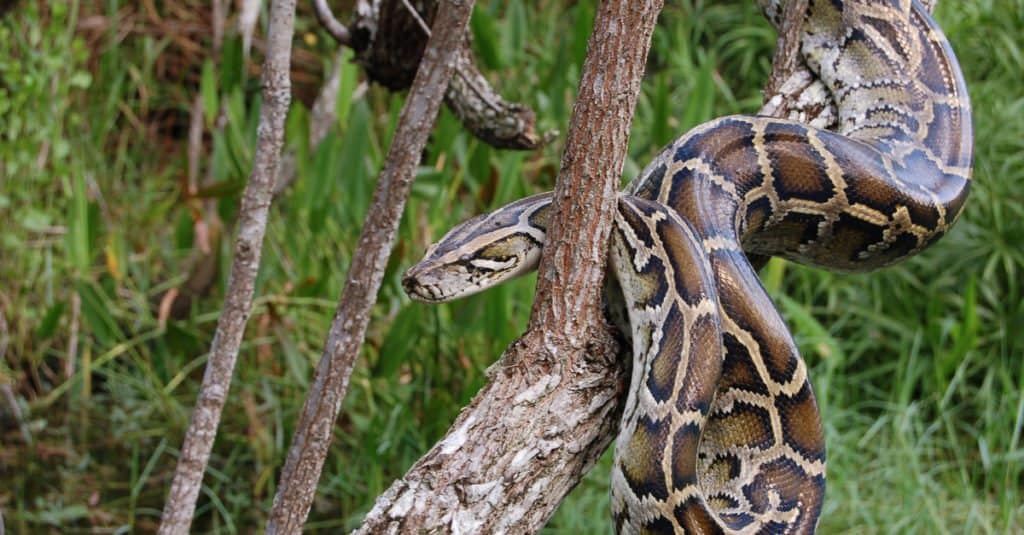Pythons don’t live in America, right? Wrong! These massive snakes aren’t just living in the United States but expanding north! Recently, news of a python spotted in Georgia is sparking worry about the presence of the invasive species and the impacts it may have on local ecosystems. Let’s take a look and see if these snakes really are a worry, plus how we got into this situation in the first place.
Pythons in North America: An Invasion of Florida

The
Burmese
python is a devastating invasive species that has spread across southern Florida and continues to head north.
©Heiko Kiera/Shutterstock.com
In the 1990s, the Everglades in southern Florida witnessed a strange phenomenon – the disappearance of small prey animals like raccoons, rabbits, and armadillos. The culprit? A newcomer that didn’t belong anywhere in the state: the Burmese python. Fast forward to December 2022, a 17-foot, 7-inch, 215-pound python was caught, breaking records. This marked the start of a growing issue as these invasive snakes steadily moved north. If certain trends continue, there could be an ecological crisis for native species.
Taking Root in the Sunshine State
It isn’t exactly clear, but most researchers believe that Burmese pythons made their way into the swamps and Everglades of the state after the illegal release of pets. Much of the time, non-native pets don’t make it long, but Florida’s warm, wet environment was nearly an exact match for the hot wetlands of Southeast Asia.
As they settled in, native wildlife suffered. Populations of bobcats, raccoons, and opossums staggered, then fell in some places by up to 87%. Even marsh rabbits, cottontails, foxes, deer, and alligators were dying to these incredible predators. The size and predatory nature of the Burmese python enables them to eat pretty much everything, even something as large as a gator.
Heading North: Pythons in Georgia

As pythons move north, individuals have been found as far as Georgia and as far west as Louisiana.
©Thomas Barrat/Shutterstock.com
For years, the invasive snakes made their home in the Everglades and the far southern reaches of Florida, but as some findings reveal, they could be on the move.
Research shows that Burmese pythons are creeping, or slithering rather, northward into the areas around Miami. At the same time, they are expanding westward toward the Gulf Coast, sometimes reaching Lake Okeechobee.
For the real kicker, they’ve finally crossed state lines. Pythons found in Georgia and Louisiana show that the snakes could adapt.
The winter of 2010-2011 illustrated this adaptability. Most of the time, pythons die in the cold, but certain snakes seem to be adapting to new weather patterns. On top of that, scientists predict that as the climate warms, the available territory of the Burmese python will drastically increase, with no real upper limit in sight. Some researchers say that they could even reach as far north as Canada.
In only a few decades, Burmese pythons have moved from the Florida Keys to the mainland and from the mainland north into the borders of other states. The invasion of the Burmese python has begun!
Why Are Burmese Pythons an Issue?
Burmese pythons have become a major concern for several reasons. First, they lack significant natural predators in their newfound American habitat. With no effective checks and balances, their populations have exploded. The consequence? A catastrophic impact on native wildlife. In delicate ecosystems like the Florida Everglades, wild swings in predator-prey relationships could have destructive impacts on everything, including the region’s flora.
Active Efforts to Stop the Slithering Spread
Thankfully, many people are working to keep their numbers in check. One of the most popular ways? The Florida Python Challenge.
In 2022, this competition brought together nearly 1,000 people worldwide for a strange but effective competition. During the 10-day event, 231 Burmese pythons were removed from the wild. Matthew Concepcion won, capturing 28 pythons and landing a massive $10,000 Ultimate Grand Prize! Another winner, Dustin Crum, won a $1,500 grand prize for finding the longest python of the competition, a monster measuring 11 feet and 0.24 inches.
On top of human intervention, some research shows that bobcats and cougars in the area may be helping to stop the spread. There is the predation of smaller snakes, but one of the more interesting behaviors seen involves eggs. Bobcats have been seen seeking out Burmese nests and eating entire clutches of eggs, a far more effective way of wiping snakes out than eating adults.
This and other more “structured” events are underway in hopes of reducing the Burmese python spread. Right now, it’s hard to see if the efforts are working, but it’s most definitely a race against the clock. As of 2022, Georgia banned the ownership and breeding of Burmese pythons. The state also required existing owners to register their snakes by December 2023.
Discover the "Monster" Snake 5X Bigger than an Anaconda
Every day A-Z Animals sends out some of the most incredible facts in the world from our free newsletter. Want to discover the 10 most beautiful snakes in the world, a "snake island" where you're never more than 3 feet from danger, or a "monster" snake 5X larger than an anaconda? Then sign up right now and you'll start receiving our daily newsletter absolutely free.
Thank you for reading! Have some feedback for us? Contact the AZ Animals editorial team.








